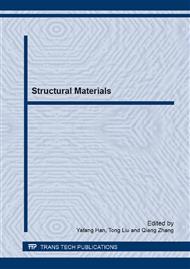[1]
E. A. Starke Jr., J. T. Staley, Application of modern aluminum alloys to aircraft, Prog Aerosp Sci. 32(1996) 131-172.
Google Scholar
[2]
A. Heinz, A. Haszler, C. Keidel, S. Moldenhauer, R. Benedictus, W. S. Miller, Recent development in aluminium alloys for aerospace applications, Mater. Sci. Eng.A. 280(2000) 102-107.
DOI: 10.1016/s0921-5093(99)00674-7
Google Scholar
[3]
N. M. Han, X. M. Zhang, S. D. Liu, B. Ke, X. Xin, Effects of pre-stretching and ageing on the strength and fracture toughness of aluminum alloy 7050, Mater. Sci. Eng.A. 528(2011) 3714-3721.
DOI: 10.1016/j.msea.2011.01.068
Google Scholar
[4]
N. M. Han, X. M. Zhang, S. D. Liu, D. G. He, R. Zhang, Effect of solution treatment on the strength and fracture toughness of aluminum alloy 7050, J Alloy Compd. 509(2011) 4138-4145.
DOI: 10.1016/j.jallcom.2011.01.005
Google Scholar
[5]
Z. Li, B. Xiong, Y. Zhang, B. Zhu, F. Wang, H. Liu, Microstructural evolution of aluminum alloy 7B04 thick plate by various thermal treatments, T Nonferr Metal Soc. 18(2008) 40-45.
DOI: 10.1016/s1003-6326(08)60008-4
Google Scholar
[6]
Z. Li, B. Xiong, Y. Zhang, B. Zhu, F. Wang, H. Liu, Investigation on strength, toughness and microstructure of an Al–Zn–Mg–Cu alloy pre-stretched thick plates in various ageing tempers, J Mater Process Tech. 209(2009) 2021-(2027).
DOI: 10.1016/j.jmatprotec.2008.04.052
Google Scholar
[7]
J. Schubbe, Plate Thickness Variation Effects on Crack Growth Rates in 7050-T7451 Alloy Thick Plate, J Mater Eng Perform. 20(2011) 147-154.
DOI: 10.1007/s11665-010-9657-6
Google Scholar
[8]
J. S. Robinson, R. L. Cudd, D. A. Tanner, G. P. Dolan, Quench sensitivity and tensile property inhomogeneity in 7010 forgings, J Mater Process Tech. 119(2001) 261-267.
DOI: 10.1016/s0924-0136(01)00927-x
Google Scholar
[9]
S. Joel J., Fatigue crack propagation in 7050-T7451 plate alloy, Eng Fract Mech. 76(2009) 1037-1048.
DOI: 10.1016/j.engfracmech.2009.01.006
Google Scholar
[10]
X. Zhang, W. Liu, S. Liu, M. Zhou, Effect of processing parameters on quench sensitivity of an AA7050 sheet, Mater. Sci. Eng.A. 528(2011) 795-802.
DOI: 10.1016/j.msea.2010.07.033
Google Scholar
[11]
P. Li, B. Xiong, Y. Zhang, Z. Li, B. Zhu, F. Wang, H. Liu, Quench sensitivity and microstructure character of high strength AA7050, T Nonferr Metal Soc. 22(2012) 268-274.
DOI: 10.1016/s1003-6326(11)61170-9
Google Scholar
[12]
D. Dumont, A. Deschamps, Y. Brechet, A model for predicting fracture mode and toughness in 7000 series aluminium alloys, Acta Mater. 52(2004) 2529-2540.
DOI: 10.1016/j.actamat.2004.01.044
Google Scholar
[13]
T. Pardoen, D. Dumont, A. Deschamps, Y. Brechet, Grain boundary versus transgranular ductile failure, J Mech Phys Solids. 51(2003) 637-665.
DOI: 10.1016/s0022-5096(02)00102-3
Google Scholar
[14]
G. Ludtka, D. Laughlin, The influence of microstructure and strength on the fracture mode and toughness of 7XXX series aluminum alloys, Metall Mater Trans A. 13(1982) 411-425.
DOI: 10.1007/bf02643350
Google Scholar
[15]
N. Deshpande, A. Gokhale, D. Denzer, J. Liu, Relationship Between Fracture Toughness, Fracture Path, and Microstructure of 7050 Aluminum Alloy:Part I. Quantitative Characterization, Metall Mater Trans A. 29(1998) 1191-1201.
DOI: 10.1007/s11661-998-0246-3
Google Scholar
[16]
B. Morere, J. Ehrström, P. Gregson, I. Sinclair, Microstructural effects on fracture toughness in AA7010 plate, Metall Mater Trans A. 31(2000) 2503-2515.
DOI: 10.1007/s11661-000-0195-y
Google Scholar
[17]
S. Suresh, Further remarks on the micromechanisms of fatigue crack growth retardation following overloads, Eng Fract Mech. 21(1985) 1169-1170.
DOI: 10.1016/0013-7944(85)90175-4
Google Scholar


